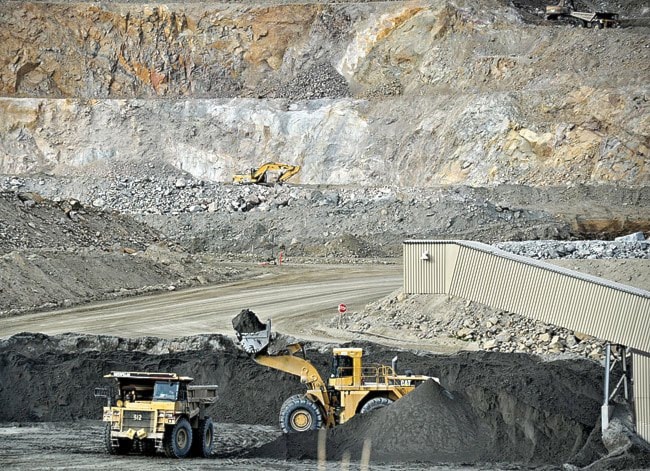Minto, one of the Yukon’s few operating mines, lost money in 2013 according to annual financial information released by its parent Capstone in February. Minto employs lots of Yukoners and contributes millions of tax and royalty dollars to both the Selkirk First Nation and the Yukon government. Any threat to its continued operations would be worrisome.
So how worried do we need to be?
Mining is famously a boom-and-bust industry. You need to make big money during the booms, and be lean and productive when the busts come along.
Minto’s main product is copper, and we’re probably somewhere in the middle between copper’s boom and bust. Copper is a key industrial and consumer metal used in everything from consumer electronics to home wiring to big industrial applications. Its outlook is tightly tied to global economic growth, especially the big rapidly developing economies from Brazil to China.
Economic growth in China has wobbled recently but most forecasters still predict growth of over seven per cent, which would be considered a boom in any rich country. Plus the outlook remains positive for other major rapidly developing economies like Brazil, South Africa, India and Indonesia.
This is reflected in copper prices. The metal is down from its peak of around US$10,000 per tonne in 2011, hitting three-year lows in London of around US$6,500 per tonne. Markets have been spooked by reports of sputtering demand in China and worries about large overhangs of copper owned by increasingly nervous copper speculators. The concern is that these speculators may start dumping the metal to cut their losses.
However, copper prices remain high by long-term standards. The Economist published a chart of inflation-adjusted copper prices. It showed that, even with the recent slump, copper prices are still double or triple where they were in the late 1990s and early 2000s when copper prices were as low as US$2,000 per tonne (adjusted for inflation). Indeed, until the surge in copper prices that began around 2005, the last time the metal spent prolonged periods above US$6,000 per tonne in today’s money was in the mid-1970s.
So, supposing that we are somewhere in between copper’s boom and bust, what does it mean if a mine lost money in 2013?
You can’t just look at Capstone’s corporate financials, since they own a few other copper mines around the world. However, Capstone released some interesting Minto-specific numbers for investors.
It turns out that Minto generated $99 million in revenue in 2013, with production costs of $75 million, royalties of $2 million and “depletion and amortization” of $44 million.
That produced a net loss for Minto of $22 million, compared to a profit of $20 million the year before.
Company officials told Whitehorse media that lower copper prices were a major culprit in the reversal of fortunes. The mine laid off some workers recently, but is continuing to process ore from its stockpile and has applied for permits to expand operations into its nearby Minto North property. The hope is that improved operational efficiency will help cut the cost per pound of copper produced.
It’s also worth noting that the Minto mine was still cash-positive in 2013. Its cash cost per pound was US$1.93 compared to average revenue of $3.30 per pound. The 2013 loss included non-cash items like the depletion and amortization cost mentioned above. This includes things like the depreciation on mining equipment, where the cost of the equipment is spread over however many years the asset is expected to last.
If a mine is already built and equipped, it makes sense to keep it running as long as it is cash-positive. However, in the long-run if the mine is not profitable enough to cover its full costs then investors will ask hard questions about investing more capital in replacing equipment or expanding it.
The cash-positive performance of Minto also means that management has time to improve efficiency and develop those additional deposits nearby to improve the economics. So Yukoners probably don’t need to get too worried about Minto just yet.
The stock market also seems relatively unconcerned. Capstone’s share price was around $2.75 earlier this week, in the $2-3 range it has been trading in since early 2012.
However, if copper prices go down to US$6,000 per tonne or lower and stay there the situation will be worth watching closely. The same goes if there are delays getting regulatory approval for the Minto North and other new deposits the mine wants to develop. Minto announced in January that its Phase V/VI regulatory application for Minto North was delayed and that this would result in “the shift of the most significant production from Minto North by one year from 2015 to 2016.”
Any further delays, either on the part of the company or of regulators reviewing its applications, will be worrisome. In the meantime, the company says it will face higher cash costs in 2014 as it waits for the new deposits to come on stream.
All of this underlines the complexity of managing a modern mine. There are so many moving parts such as copper prices, geology, engineering, operational cost control and our regulatory processes. Yukoners will be watching how Minto’s bosses steer through them with interest.
Keith Halliday is a Yukon economist and author of the MacBride Museum’s Aurore of the Yukon series of historical children’s adventure novels. You can follow him on Channel 9’s Yukonomist show or Twitter @hallidaykeith
